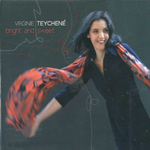This review page is supported in part by the sponsors whose ad banners are displayed below |
 |
 |
|
 |
Sound. Channel Classics records are being very carefully mastered to make Dvořák’s Symphonies 8 & 9 under Ivan Fischer a good test bed both musically and technically. For example follow the delicacy in the "Largo" of the 9th Symphony, the ability to create a complex image in the final "Allegro Con Fuoco" or the superposition of various timbres all along these symphonies. This album is a native DSD production where the Totaldac reproduced all the rich timbres fully. Each musical nuance of every instrumental group was easily readable without need to concentrate yet without unnatural zoom effects. The total image was full and solid whilst being suffused with air from bass to treble. The sound appeared very consistent and almost tempted me to bite into it. |
|
Comparisons to the Lumin streamer were quite easy. If the Lumin’s fluidity remained at a wonderful level, the Totaldac’s tangibility had gone and the music felt less present. More obviously and objectively, the quantity of information the Totaldac pushed at the amplifier and speakers was far more important. With it there was a multitude of additional information lacking any analytical or surgical aspects to remain imperturbably natural.
The Totaldac seemed to tell me: "Hey there, here is everything you have on that file you asked me to play."
|
|
|
|
The few times I previously had such tactile encounters with music in all its fullness of perfectly distinguishable stacked timbres was during concerts in outstanding acoustics sitting a few meters from the stage like at the Pleyel in Paris or the Haus für Mozart in Salzburg. With all DSD albums from Channel Classics but also remastered Sony analog tapes for Miles Davis, the conclusion was identical: huge data density, natural musicality and intense pleasure. On Seven Steps to Heaven by Miles Davis, maybe for the first time I got an inkling of what it might have been like to hear him live – sometimes wistful, sometimes forceful. Admittedly this was but a dream but how thrilling nonetheless.
|
|
|
|
 |
|
 |
After this first DSD match against the Lumin came a PCM duel with the Ayon S5 streamer. Although the designs are quite different (4 x BB1704K plus 2 x 6H30 valves per channel for the S5), their sound aesthetics were very close. On "Don't get scared" by Virginie Teychené (PCM 16/44), they were on par for liquid lifelike sound and tone. But the crazy Totaldac d1-server + d1-dual (or d1-tube) combo again succeeded in delivering far more information to the speakers! In addition the French combo appeared a bit more involving than the Ayon S5. |
|
Digital volume control. Volume control in hifi is more complex than it first appears. With an integrated amplifier the question becomes less crucial unless you can bypass its preamp stage to convert into a power amp. With a power amp picking just the right preamp becomes another audiophile headache to end up with one’s sonic ideal. The preamp’s job is to adjust volume in the voltage domain and match impedance between source and amp.
Unlike numerous notions and illusions, a preamplifier and additional interconnect between source and power amplifier cannot improve the source [a statement true in theory but duly contradicted in practice below - Ed]. To prefer one preamplifier over another is simply choosing the kind of faults we can live with and also a function of the impedance adaptation. With no need of volume control, the best theoretical configuration would be a direct connection between source and power amplifier, subject of course to correct impedance matching again.
|
|
|
On all converters which I used until now, digital volume was quite destructive to dynamics, timbres and imaging. Software volume by computer was often worse still. Cheap but very good preamplifiers like SPL’s Volume 2 or a well-designed passive preamplifier appeared far superior. Yet bear in mind that digital gain adjustments are embedded in all our recordings (except for direct-to-disc DSD masters which are exceedingly rare). Mixing in studios relies on digital gain trim, albeit often running with proprietary algorithms and extensive computations at 64-bit precision. With computers the accumulation of rounding errors becomes a key issue. Totaldac’s solution operates at 69 bits as the only hard information we have about it to protect their IP. I compared this digital implementation to my SPL Volume 2 and 6H30-fitted Ayon S5.
For the SPL Volume 2, the conclusion was straightforward. The Totaldac’s digital volume control was much better in every aspect but mostly so for timbres and dynamics. With the 6H30 preamplifier, comparisons grew far more complex. Results depended on albums. I couldn’t even establish coarse correlations, say with music types like intimate versus Wagnerian. In some instances the analog domain beat digital when the latter flattened out soundstage depth and narrowed width. In other cases the digital volume had the higher precision, better timbres and no imaging losses. That said, these offset were tiny in either direction.
|
 |
  |
 |